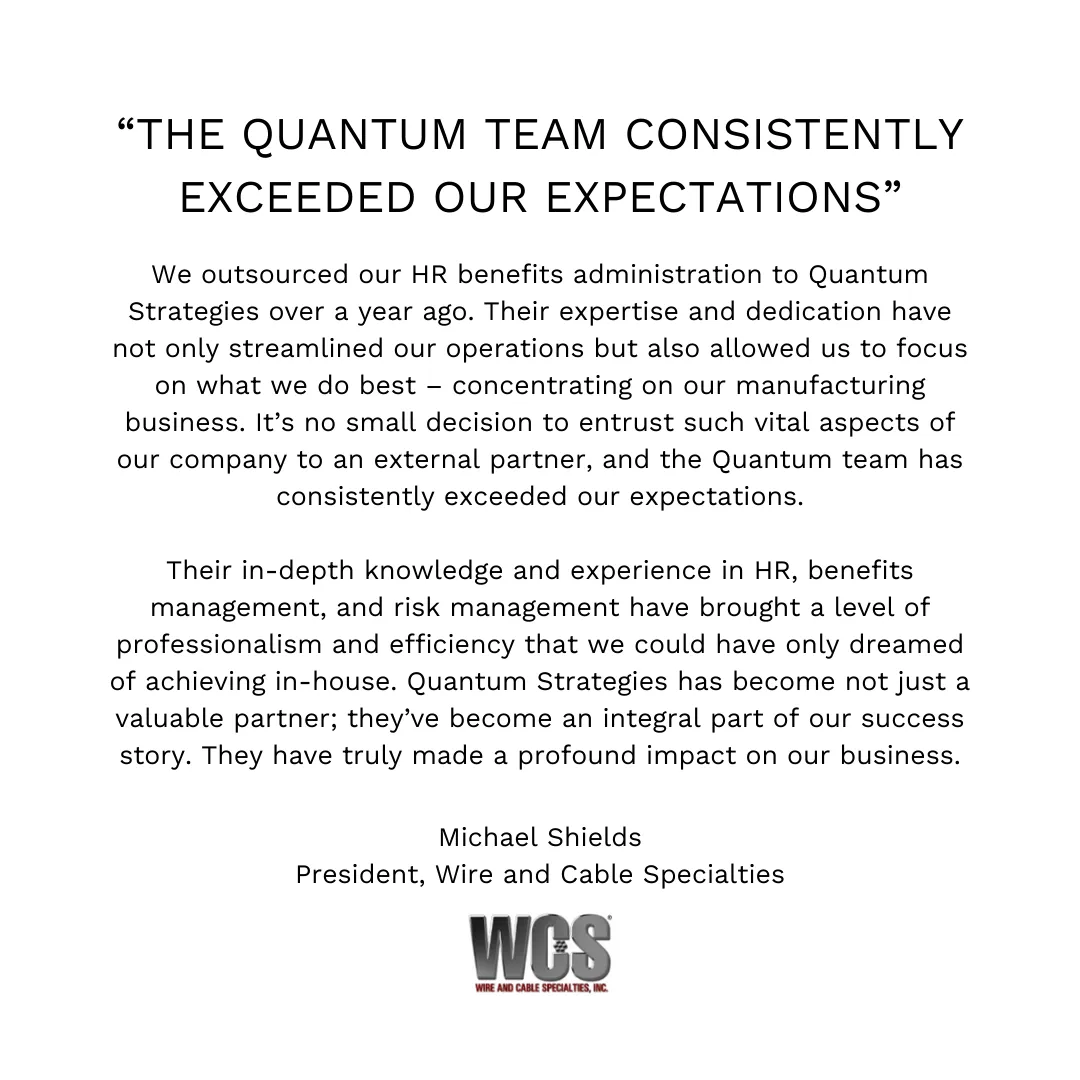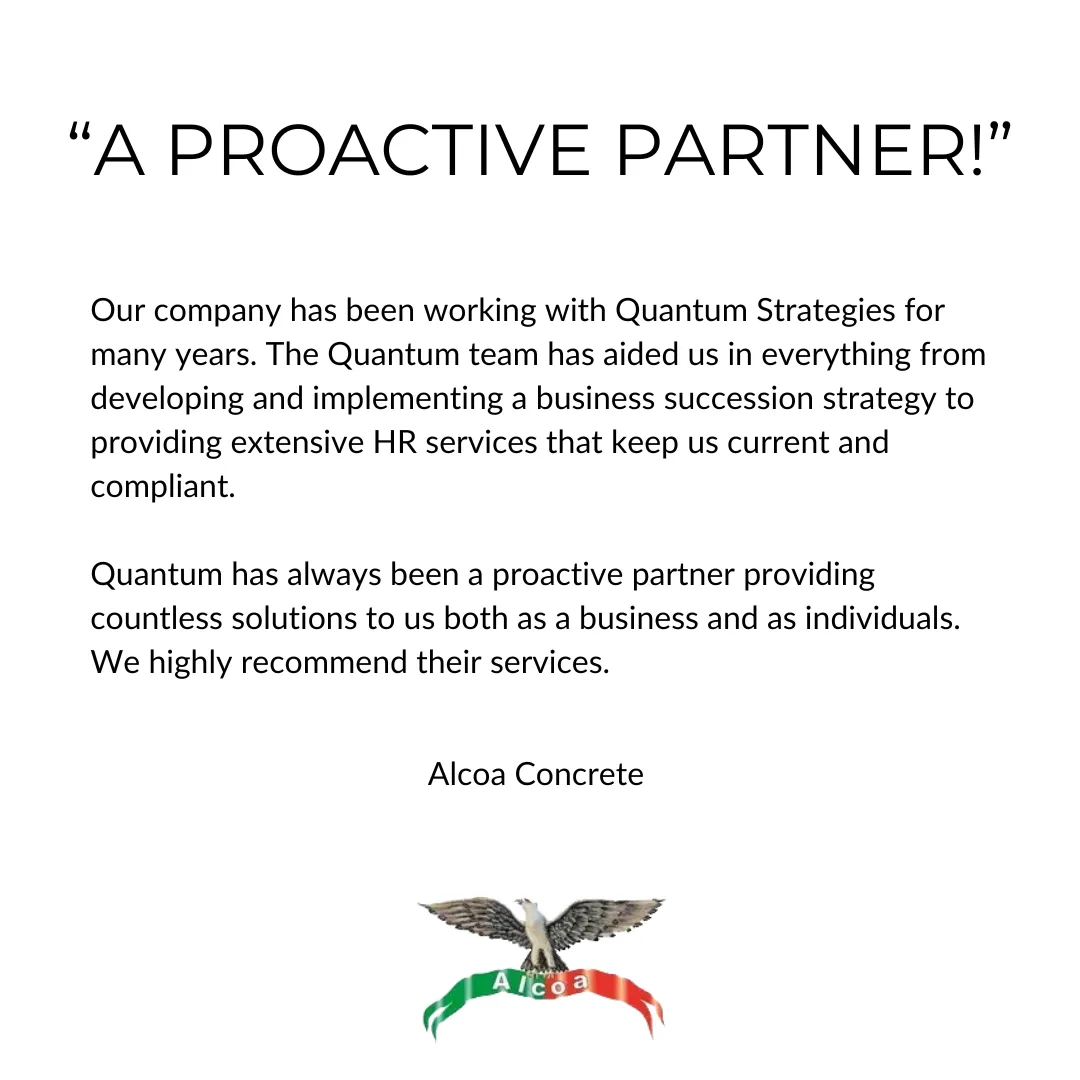Tailored HR Solutions as Unique as Your Business
Expert consulting and service to elevate your HR from a headache to a value driver.
Does Your HR Function Make the Grade?
Take our 5-minute quiz and evaluate the effectiveness of your HR function.

How We Help
We Focus on Your HR Needs,
So You Can Focus on Your Mission.
At Quantum Strategies, we understand that effective human resource management is the cornerstone of every successful business, regardless of size. Our mission is to provide tailored HR solutions that align perfectly with your unique business needs and growth stage.
Our Services
Navigating Change with Confidence: Quantum Expert HR Solutions
From Policy Assistance to Leadership Succession Planning, Quantum Strategies is Your Ultimate HR Resource to Solve Your Business Challenges.
HR Operational
Assessments
Unlock the full potential of your HR department. Our collaborative approach brings clarity and efficiency to your HR operations, providing a thorough analysis of your department's structure, costs, effectiveness, and needs.
Comprehensive Analysis: Detailed evaluation of your organization, workgroups, and individual roles for optimized efficiency.
Objective Insights: Receive a clear blueprint highlighting your HR department's strengths, weaknesses, and gaps.
Strategic Recommendations: Actionable plans focusing on technology utilization, communication enhancement, and leveraging department strengths.
HR Consulting and Managed Services
Tailored to align with your unique needs, our HR consulting and managed services enhance operational efficiency and effectiveness, allowing you to focus on your core mission while we optimize your HR investment.
Expert Supplemental Support: Strengthen your existing HR team with specialized expertise to navigate complex HR landscapes.
Personalized, Agile Solutions: Customized services for organizations with or without HR teams, adaptable to your specific requirements.
Goal-Oriented, Clear Communication: Delivering precise, actionable strategies that align with your organization’s goals and ensure successful execution.
Custom HRIS Design and Integration
Revolutionize your HR data management. Our team will evaluate your current human resources technology stack, offer recommendations, and then integrate your new and existing systems with our cutting-edge technology, ensuring seamless data flow and optimized operational efficiency.
Seamless Integration: Connect legacy systems with modern platforms for streamlined data management.
Tailored Design: Custom HRIS solutions uniquely crafted to meet your specific business needs.
Advanced Analytics: Leverage data-driven insights for strategic decision-making and operational excellence.
“Successfully steering through the specialized HR challenges within organizations of all kinds demands expert understanding, strategic planning, and precise implementation. With comprehensive knowledge of these challenges and the right solutions, your business can stay focused and successful in their vital missions.”
William J. Rizzo

Who we Are.
We Focus on Your HR Needs,
So You Can Focus on Your Mission.
At Quantum Strategies, we recognize that proficient management of human resources is fundamental to the success of any enterprise, irrespective of its scale. Our objective is to deliver customized human resource solutions that are in perfect harmony with your distinct business requirements and developmental phase.
Constant Improvement
Commitment to Customers
High Level Of Knowledge
Best Service You Can Get



Why Choose Us
A True Partner to Solve Your Most Complex HR Challenges.
Empowering HR Innovation and Compliance
Commitment to 100% Client Satisfaction
People-First Approach

Peace of Mind:
Handle ongoing compliance with ease

Employee Satisfaction:
Build a positive workplace with engaged employees

Strategic Confidence:
Drive strategy with advanced analytics

Leadership Development:
Equip your team with the tools to lead

2,245 +
Happy Clients

25 +
Years Of Experience

120 +
Professional Team
Testimonials
The Quantum Commitment - 100% CLIENT SATISFACTION!
At Quantum, we understand that your satisfaction matters most, and The Quantum Commitment is our way of putting that understanding into action. Experience the difference with a team that is dedicated to making your satisfaction the cornerstone of our service. Because when you choose Quantum, you choose excellence, reliability, and a commitment to exceeding your expectations every time.
Our Resources
Unveiling Proven Strategies and Insights.
Discover actionable tips, expert advice, and industry insights to fuel your journey towards success.

Fostering a Psychologically Safe Workspace
As we navigate the complexities of the post-pandemic world, the importance of mental health in the workplace has surged to unprecedented levels. According to research from the
American Psychological Association, 81% of employees are now actively seeking workplaces prioritizing mental well-being.
Key Challenges Faced by Human Resources in Nonprofit Organizations
The nonprofit sector brings its own set of specialized difficulties, especially in the area of human resources (HR). Although these difficulties may share some common ground with those in the for-profit industry, they possess unique characteristics that require special attention from nonprofit leaders.
FOUND THESE HELPFUL?
Explore Additional Articles and Resources In Our Blog

Mastering Prioritization: The Key to Effective Leadership
Any CEO, leadership role, or manager faces considerable critical thinking and pressure daily on making profits, keeping employees and clients happy, growing the business, and innovating or bringing new ideas to the table. While many leaders are good at project, task, and time management, short and long-term success only sometimes follows. This could result mainly because of many leaders' inability to prioritize tasks. To enact effective prioritization, you must be able to manage the entire project's direction on a macro level and individual functions on a micro level.
Project Management Versus Task Management
According to productmanager.org, Product management is "the application of knowledge, skills, tools, and techniques to project activities to meet the project requirements." Task management is "a process where one identifies, monitors, and progresses the work that needs to be done during the day."
To simplify, project management focuses on the entire project, which looks at the larger picture. In contrast, task management focuses on the project's objectives that you must achieve daily, weekly, or monthly. It is hard to do everything simultaneously, and it is a mistake to think about the task and work on it to impact your productivity gains significantly. In business, important goals are usually the larger picture that comes at the end, and effective management can be achieved.
Evaluate current practices
Even if no prioritization plan is set in stone, our mind tends to sort out work in a specific order. Our mind's way of subconsciously giving some tasks importance over others is to have a plan for these priority tasks we have created without realizing it. Take time to provide a thorough evaluation and implement teamwork to increase flexibility. Once we understand our current practices, they can be further developed or tweaked to understand tasks requiring more or less immediate attention.
To understand this method of prioritizing, we must first learn the difference between 'important' and 'urgent' tasks.
Important "marked by or indicative of significant worth or consequence.
Urgent "calling for immediate attention"
Dwight DE. Eisenhower as the 34th president of the United States of America, you can imagine the number of tasks and the amount of pressure on President Eisenhower must have been enormous at the time, and the only way he could efficiently manage all of this was by prioritization. To do this, he created the Eisenhower matrix, which differentiated between important vs. not important and urgent vs. non-urgent; this method aimed to filter out the noise and focus on what was truly important.
Priority 1 tasks are both urgent and important
Priority 2 tasks are important but not urgent
Priority 3 tasks are urgent but not important
Priority 3 tasks are neither urgent nor important
Important/urgent tasks need to be done immediately and by the leader
Important/not urgent tasks need to be done shortly with a set timeline and by the leader
Not important/urgent tasks are something a leadership position should be able to delegate
Not important/not urgent tasks are something that can be dropped or pushed to a later date
These tasks can change quickly from one quadrant to another, and monitoring those changes is important. If a task in the not important/ not urgent quadrant moves to an important / not urgent quadrant, then clearly, the prioritizing functions have changed, and the leader should act accordingly.

Leading down the chain of command
Creating a leadership chain of command will allow you to delegate tasks to other team members, focus on the most critical work, and leave the rest to teamwork. As an effective leader, it is your job to manage your leadership chain. To delegate appropriate tasks. It is vital to understand which tasks should be done by the leader and which tasks can be delegated. Tasks that are usually confidential, high in value, and require experience or expertise should be done by someone in a leadership position. Delegating tasks is essential to effective prioritization because it is only possible to do so many tasks at a time.
When assigning tasks, you must be able to communicate with your team members. Since you rely on them, you need to be sure they have all the information to get their task done right and effectively. Pass situational awareness up and down the hierarchy of employees through unified command. You do this by breaking down teams into manageable groups with junior leaders. A good leader will empower their junior leaders to lead through trust and confidence. Junior leaders should naturally take the initiative and state, "This is what I am going to do," instead of a mindset where they ask, "What should I do." Get input from team members and junior leaders, and this will empower them and encourage a better culture.
As a leader, it is impossible and leads to low productivity to complete every task and make all the decision-making yourself. Initially, leaders can still be hands-on, but they will eventually have to let go. In business, it is not uncommon to see shrinking resources and increasing demand, and this is where it usually shows how much of a significant impact someone can have on their teams as a leader. A leader can tackle this situation by being less 'involved' and more 'essential.' Being involved' is all about making choices and mandates in the work that is done by the team, and being 'essential' is how well the leader activates people around them to do tasks that lead to both short and long-term success.
Often, a new leader will feel that delegating essential tasks is passing the work on to someone else, therefore acting as a company resource and time waster. When they are, delegating essential tasks is a valuable tool if used properly. It can make workloads more manageable and create an excellent environment to grow and learn.
Why does effective leadership usually feel they can do it better? A study by Pfeffer, Cialdini, et al. found two psychological processes that make someone in a leadership role reluctant to delegate work:
1) The self-enhancement effect is a manager's inclination to prefer a work product when they are more involved in its production.
2) The faith in supervision effect, which is when employees tend to believe that work is performed at a higher level when a supervisor overlooks it
Great leaders always need to be aware of these biases. They can indicate that trust needs to be built with the team.

How to delegate tasks effectively
1. Choosing the right person for the job
As a new leader, it is imperative to understand a team member's strengths and weaknesses. The leader can only delegate the task successfully if they know which team member can take responsibility for the task at hand.
For example, delegation requires much collaboration with the person taking responsibility; picking someone who likes to work independently will be counterproductive. Another way to delegate is to sit down with the team with a list of essential tasks and allow the team to pick the functions that they think best suit them. Letting people choose the task can help build trust and improve engagement
2. Explain why you are delegating
If a task or other vital goals are delegated to someone, it is also good to mention why the task is being delegated. Delegating a task is usually a careful and calculated thought. Since some effort goes into selecting the right person, it will be helpful to let them know why they got picked to take up the responsibility.
3. Provide the right instructions
Every effective leader should be able to efficiently and efficiently provide the proper instructions to the team members without micromanaging. By this, we mean providing them with instructions that will let people go out on their own to achieve these tasks, and the instructions provided should enable them to accomplish these tasks with ease.
4. Provide resources and training
As we mentioned earlier, delegating is not passing on responsibility to someone else but more like activating those around you to take up more influence and responsibility and to improve your growth mindset. This requires not only time and trust but also training and resources. Many people have potential, but that is not readily accessible. Great leaders must invest away from time wasters and move towards training and development to unlock their full potential. Relying entirely on ability and talent can hit a ceiling. It works best when these talented individuals get the right resources to carry out their responsibilities effectively.
Connect
Keep Up with Our Latest News and Insights
Subscribe to Quantum Strategies' latest updates and insights.
Office: Philadelphia, PA | Glen Mills, PA | Washington, DC
Call 610.624.1770
Email: info@QS2500.com
Site: www.QS2500.com






